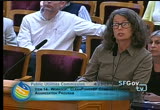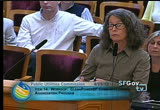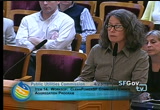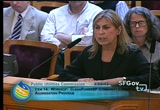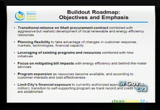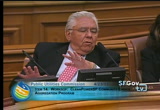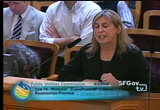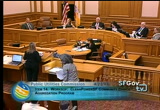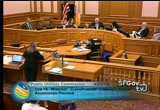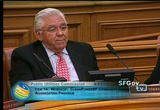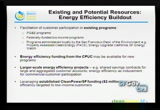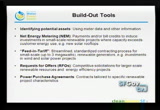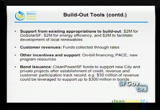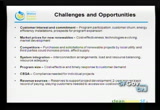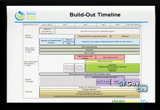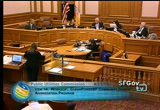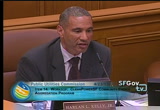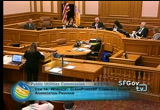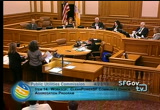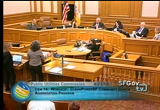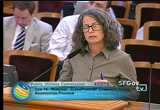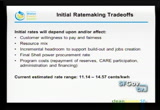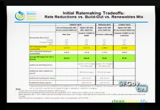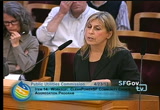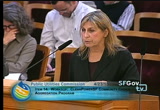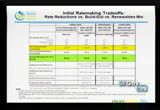tv [untitled] April 24, 2013 4:00am-4:30am PDT
4:00 am
>> correct. they say in their filing they wish to keep the option open. >> right. but the code of conduct, what's the number? >> ab 97 0. >> ab 97 0 is saying they need to? >> yes. and the state of california regulatory entity, the california puc laid out specifically rules for what it means to implement that state law and we don't believe they have met those requirements. >> thank you. >> and then the second item is -- yes. >> [speaker not understood]. >> i beg your pardon? >> the date was march 31. >> that's correct. >> so, there's been no ruling on that? >> no. march 23 '03 -- march 31 was when the filing was due. ~ on friday, people like ours, parties, made responses. on friday we started -- or monday, excuse me, we provided our response. and now the record is before the california puc to make their decision. and this is in the context of a
4:01 am
filing that will be presented to the commission by their energy division staff as well. it wouldn't naturally go into a hearing mode unless the commission directs it to. then the other item i wanted to make sure you were aware of was the green turf option filing that pg&e made. they made that filing last year, and now they have filed a motion for settlement asking the california puc to approve a revised program. we will provide you with written summary of that modified request and have an opportunity then to talk with you about it at our next commission meeting. the basics of it are pg&e has, in our view, improved the program. you know, we are on record as supporting green tariff options. we have said that to the california public utilities commission, but we are concerned with the details of
4:02 am
the program that pg&e has now presented in the settlement form. we are concerned about the cost-shifting that may occur between pg&e's existing programs and this new program. they're able to -- they haven't been clear as to how they're going to recover the costs of the program. and as you've seen in our discussions of setting the rates for our clean power s.f. program, it matters how cost competitive your program is. it really matters how you recover those costs. and if nonparticipating customers are helping pg&e recover some of those costs, then that means they're not -- the participating customers aren't. and it's disadvantaging competitors like our cca program. so, we will be -- we intend to develop comments to the cpuc along those lines, raising our concerns about the details. but we are happy to see that
4:03 am
pg&e's settlement proposal for the green tariff option does include the prospect, the possibility of local renewables being constructed. we're concerned that it doesn't make a strong enough commitment towards that. it doesn't give enough detail as to how they're going to accomplish that. but we are happy to see that they are making statements suggesting that they intend for that to be a part of the program at some point in the future. do you have any questions on those item that i've given you a quick run down on? so, then, let me turn it over to our new director kim malcolm to go over the build out framework. thank you. >> good afternoon, commissioners. >> welcome, ms. malcolm. >> thank you. i thought i'd start by saying that i spent my last few weeks actually [speaker not understood] meeting with the puc staff and a lot of time with staff and managers and with stakeholders.
4:04 am
and i have also had many opportunities to review the kinds of analysis that have been performed by the staff and by the puc consultants on the cca. and i'm quite impressed. i also believe that we are -- we can be successful in this program from what i've seen so far. and i think we're allred i to move forward. so, with that, as barbara said, i'm here to talk about two thing that you asked us to report to you on. the first is some kind of indication of the process of build out that we envision, and the other is how we can reduce the customer rate. so, starting with the first -- i'm also aware that you may have heard some of the stuff [speaker not understood] and i will try not to be redundant. and i welcome your questions and comments at any time.
4:05 am
i'm first going to tell you a little bit about the objectives and emphasis of the buildout program. talk a little about the components of the buildout program, the tools that we can use to induce investment, the challenges that we envision. and then we've created a little timeline to give you some idea of what we think we can accomplish in the first four or five years of the program. and then in a second but related part of my presentation i'll talk about some rate making options that we'd like you to consider. as you all know, we're considering the shell contract to be conditional as the city develops a diverse portfolio of energy resources that emphasizes renewables and energy efficiency. we hope to maintain -- >> how do you define the word transitional?
4:06 am
>> well, the contract we've been negotiating is for 4-1/2 years. how we use those supplies over the coming 4-1/2 years will depend on whether we can implement cost-effective program expansion to other neighborhoods, other types of customers. the kind of resources that we can get as new supply and the cost of those resources. we don't know right now how much buildout we can actually accomplish in four years. that's sort of the next stage of our planning effort. >> i get that. i'm more concerned about what kind of product shell is going to put on the table that are truly green. or are we -- and what kind of mechanisms do we have to protect and to ensure that those are renewables that are going to meet the test of a consumer who says, all right,
4:07 am
i'm willing to pay for this, maybe even more than pg&e has, but i want to be assured that these products are green? >> whatever the resource mix that the city chooses under the new shell contract, all of the products that shell will purchase for the city will be california certified green. as you probably know, there are three categories of green products. >> yes. >> one emphasizes contractual relationships with california, producers and other out of state producers. and another is a payment and the nature of a premium for green power but without a contractual relationship. and it's a complicated set of equations and we can get you more information about that if you're interested. >> well, we have to be interested because we have to -- at the end of the day, we're held responsible to the rate payers to make sure that
4:08 am
whatever product is put out there and whatever final agreement is signed with shell reflects the concerns and the interests of the rate payers in this city and county. >> yes. >> same way that sonoma is dealing with that, marin has dealt with that, and a few other similar projects in other states have been dealing with that. >> yes, we would still have 100% green product, but you're correct, there may be different perceptions about how green the total portfolio might be. if you want, we can move ahead to the proposals that we have that show you how resource mix affects rates. >> i would defer that to the members of the commission if they want to move forward or stay where we're at. >> okay. >> commissioner [speaker not understood]. >> i think you should continue with your presentation. but i do think that this, you know, question of transitional and what that really means and the timeline for that and, you know, i understand, too, that
4:09 am
the resource mix is really going to be important because that's really how green is green. and that that's going to somewhat determine the rate structure which we're going to have to vote on. so, i think that part we understand, but we i think are eager to get to a place of a pretty solid recommendation of, you know, which one we should go with because that creates -- that gives us the greatest potential for successful program. one other piece on the transitional is the substitution clause which i think is quite important which my understanding is -- i don't think it's procurement. i think it has to do with local buildout. >> right. >> once we build a renewable green supply, green source, that we can then substitute what we're purchasing from shell, correct? >> if -- go ahead. >> no, you go ahead. >> no, there's a caveat to that, and you're right. >> yes, we can substitute the power or we can expand the
4:10 am
program to include other neighborhoods or other types of customers. >> right, right. okay. >> and i think those are strategic decisions that we'll be making as we go along and we'll have to do some planning, obviously, and we'll immediate some criteria for how we'll decide -- how to go about that. and we would bring those issues before you. >> and it seems to me with a local build out plan you're willing to say this is what transitional means. by end of year one or two [speaker not understood] is built, or we can either expand or substitute. >> yes. and that will be ongoing analysis that we'll have to perform. >> but we can only substitute if the caveat is met, that shell is able to sell its product in the open market to make up for the deficiency, correct? >> yes, or expand the program. >> [inaudible]. >> right. >> yes. >> [inaudible].
4:11 am
>> that's what i'm saying. >> we make a risk in that event. >> that's a substantial risk. >> yeah, and that might beg for a decision to expand rather than substitute because we're already going to be paying for it. >> assuming the base of rate payers comes to the table and says, we want to be part of that expansion. that's -- and those are the issues we need to discuss. >> yes. >> thank you. >> so, as barbara just said, that relates to our planning [speaker not understood]. the other emphasis of the build out is we'll be leveraging some new energy efficiency and renewables programs. we will anticipate infill impacts by buying energy [speaker not understood] and energy improvements. we talked a little about program expansion. and i understand that there is
4:12 am
a commitment to limit the city's financial exposure. the first component of a buildout is energy efficiency and i understand this is first in your [speaker not understood] the state of california. there are several existing programs that we can direct our cca customers to participate in. that will be one of our goals. we understand that there may be some additional funding for efficiency programs from the california public utilities commission. we can pursue larger scale inefficiency programs with rfps, especially in larger buildings, commercial and multi-family and perhaps light industrial. we've already allocated $2 million to the program to provide energy efficiency to low-income customers. the second component of the buildout are renewables.
4:13 am
and i think you probably heard this from staff before. you can encourage in different ways behind the [speaker not understood] investment. we can do investments in small and local projects as well as larger projects that will meet the city's demand. there are many ways to induce investment and to support investment in renewable and energy efficiency projects. we had some good data about demand, meter data that we can assess and perhaps elicit some interest from existing building owners. we can almost immediately [speaker not understood] a net metering task which can allow us to access power mostly from solar rooftop projects. and [speaker not understood] are easy to implement as well.
4:14 am
they are centrally streamline contracted with a standard price that hopefully would encourage new investment in small scale renewables. and we can issue request for offers and engage in power purchase contracts for larger projects that are tailored to the city's needs. we have, as you know, several million dollars to jump start this part of the process and we are going to propose to you today a way to collect some additional revenues from the customer revenues that will allow us to support this effort. there's been a lot of discussion about issuing bonds. there are many variables that go into a decision about how many bonds -- how much in bonds you might want to issue and the city's capacity for issuing bonds [speaker not understood] we can leverage about $1.25 to
4:15 am
get $10 worth of financing mechanism. this is an opportunity -- you probably heard some of this before as well. the success of the program will depend on customer interest, which [speaker not understood] has already mentioned. both in taking service from the city as well as participating in a related program. we know that the market prices for new investments will affect the success of the program as well, and we know the competitors may be competing with us for those resources in the city and driving up prices. there are issues related to system integration, in other words, connection agreements with pg&e and resource adequacy of the cta. and we will be needing to conduct some kind of c-e-q-a
4:16 am
review for almost all of the renewables. it will be some kind of c-e-q-a review. it might be limited, but we have to account for that. and then, of course, revenue sources will influence how much we can do. we've created this buildout timeline. and i thought i would just mention that there are a number of things that we can do right at launch besides just turning on the switch and offering electrical service. and i've mentioned them already. we can have a net metering tariff published. we can have a feed-in tariff published. we can work with our cca customers to get them enrolled in energy efficiency programs as we're developing new ones. and we can also issue an rfp early on to see apart of a survey that's out there and what kind of interest there is
4:17 am
in building out some new, probably smaller projects at first. do you have any questions about this timeline? >> yes, i do. i don't know why everything is starting to late. >> late? >> why wouldn't we start a lot of this stuff, you know, today, that energy metering in a substantive way, feeding tariff programs, you know? there's even some of the c-e-q-a stuff if need be. >> the net metering and the feed-in tariff, we can't purchase power until we can sell it to the customer. so, it would have to be concurrent with the launch of the -- providing [speaker not understood] to the customers. >> i don't want to kind of get in the weeds of it. i guess what's behind all this is my sort of anxious us in to really get this rolling and -- >> i know. >> and whether this is a place we can leverage hetch hetchy
4:18 am
power, for example, or i mean, i understand this is sort of a chick not and egg issue, bring the customer base on board, [speaker not understood]. but it feels like it's taking too long and there is not enough detail in what we can really launch with sooner rather than later. i know we're going to hear this with lafco as well. >> just to point out, i think the first thing we want to know is the product that we want to sell. you know, there's a lot of things we need a decision on before we start doing this because we're still not out of the woods and moving forward. things are changing. pg&e has this whole idea about, you know, this program is too expensive. we had a meeting with the sierra club and they were very concerned about launching a program, that the price is so high, that we may not be successful in rolling it out. and they do not want to see us fail.
4:19 am
and, so, they really want us to think about it. there's a lot of decisions that need to be made before i think about it. i do agree the buildout is one of the most important pieces that they identify, and this is something that we think is important. so, we wanted to kind of go out and put them in different buckets. and, so, we talked about things that once we start, we can hit the ground running. and then we talked about smaller scale and then larger scale. and as you know, the larger scale, you need c-e-q-a. and, so, we're going to get into, you know, if this is a buildout timeline, well, we need something to fund it. and, so, that's going to be the next part thev presentation. ~ of the presentation. >> yeah, i'm encouraged you want to be moving ahead and there are things we can be working on right now that will be ready as soon as we have lunch. there is a timeline and there
4:20 am
are other approvals that we need from you and implicitly at least at the board of supervisors, before we can actually sign the contract and flip the switch. >> great. i urge you to let us know what those decisions are so we can really, and hopefully before we meet with lafco so we can really be there and have a launch date and activate. >> we'll get you a timeline that backs out all of those debts. >> thank you. >> so, as i understand, we can't use hetch hetchy power, correct? >> i understand that we can use excess hetch hetchy power. >> excess hetch hetchy power. >> yes. i know todd reiskin has been working on that. >> i think your [speaker not understood] is in. i want to make sure i'm communicating correctly. barbara hale, assistant general manager for power. we can use hetch hetchy power. we need to provide it to the program in a manner consistent
4:21 am
with the raker act and in a manner that provides us with revenue neutrality from the municipal side of our operations . ~ launch so, we can provide hetch hetchy power to the program, but we can't discount it in order to make the program look better to our cca customers. because that means our municipal customers are sort of foregoing some revenues they otherwise would have achieved. >> so, if we were to use hetch hetchy power, we would have to pay full market value for it? >> well, yes. what we would have received had we sold it on the market. >> which really is a subsidy by the taxpayers? >> that we're trying to avoid that subsidy of selling it below what we otherwise would have achieved. >> right. okay. >> and i just also wanted to emphasize since i have the microphone now, commissioner vitor, as you're looking at this buildout timeline, i want to make sure you're reading it
4:22 am
the way we intend. you can see the rows describe the actual activities, the resources we're investing in. the columns are related to the program year we're in. so, on launch day, the first day customers are enrolling in this program, we are maximizing their participation in existing energy efficiency programs. meanwhile, we're also at our desks developing new programs for energy efficiency. we are -- they already know how much we will pay them for any small-scale renewable electricity that they already have operating on their roofs or that they have invested in, but that they're not consuming at their home. that's the net energy metering part of the program. day one, that tariff is available to them. same thing for the go solar s.f. program. they can take advantage of the go solar s.f. program from day one.
4:23 am
feed-in tariffs, also a published tariff available to them on the day the program begins to enroll customers. meanwhile, we're also pursuing other activities associated with the larger scale renewables where we need to do some more development and design work and c-e-q-a work before we can actually bring projects on board. that's what you see reflected in years one, two, three, and deliveries happening in two, three, four, right? and the market purchases, that's happening from day one. and then we have that series of ongoing activities that are just part of providing good customer service and a good responsive program to our customer base. so, i want to make sure that we're not missing the point of how many of these local investment opportunities and activities are happening the day the program launches. >> that all sounds good and i do think it would be helpful to
4:24 am
understand leading up to launch date, you know, what are the decisions that need to be made and how we're going to really be able to kickoff on launch date with all these programs so we're really hitting the ground running. >> great. >> and also, we are already -- we're already having conversations with project developers. they're coming to us with ideas . and there's a lot we can do between now and launch date, you're right. >> great. that's what i want to hear. >> given the resources we have. any other questions on the buildout? then i'd like to move on to the rate-making options if we're done there. i think you've already heard about these trade-offs you have when you set rates for this program. you need to consider willingness to pay and fairness, the resource mix will influence the rates that you, that you set. the amount you want to set aside for investment in the buildout will affect the rates
4:25 am
the final shell power procurement rates and other costs like the administration and financing budget. right now our estimated range of rates is 11.14 cents per kilowatt hour and 14.5 cents per kilowatt hour. if you turn the page you'll see four scenarios that we've provided. in the second column there, and these are rates and associated resource mix and buildout revenues. the second column, you can see a rate case. i believe this is the scenarios you're familiar with from previous meetings with the s.f.puc staff. that shows a large reliance on firmed and shaped shell power purchases, which has also been
4:26 am
called bucket 2 resources, green energy resources, and then 10% of bundled green product. the rate that has been published in the newspapers that you're familiar with in that scenario, 14.75 cents, and there would be nothing left there, left to use for a buildout effort. >> what's the pg&e estimate of what they're going to offer? >> the latest article i saw pg&e was estimating its green rate would be -- its basic service rate plus 3-1/2 cents, more or less, which would bring it to about 11.5 cents. ~ >> so, about 3 cents less than what we would be offering? >> yes, in that scenario. also -- well, we can get into the details. there are some things we have concerns about because of how the settlement describes how the rate would be -- >> rate concerns about the pg&e
4:27 am
rate? >> about the pg&e proposed green rate. and barbara already mentioned some of that to you. there are three other scenarios there, and each one of them assumes that under the shell contract, the city purchases 85% renewable energy credits which are very inexpensive, they are considered -- they are considered the least green of the products that are consistent with california rules . but it's the only way that we would be able to ~ get the rate down and find some revenues for buildout. so, in that scenario 1 there, if you took all of the savings from bike rec's instead of firmed and shaped revenue -- energy products, there would be about $36 million in buildout funds over 4-1/2 years. and that's the line towards the
4:28 am
bottom that says additional funding 4.5 years. so, we would be able to collect about $9 million a year. but the rate in that scenario is still very high. in the next scenario, again, the resource mix would emphasize rec's, the purchase of rec's by shell. the rate, we split the savings between the rate and the need for some reserves for buildout. so, your rate goes down to 12.86 cents, and there is about $18 million that we would collect over 4-1/2 years for buildout. and then the third scenario is the lowest rate, 11.14 cents because it applies all of the savings in purchasing rec's to the rate instead of splitting it with the buildout. and, of course, there are many other scenarios we could
4:29 am
present to you with different types of resource mix. and if you'd like us to do that, we will. we're interested in something like the second scenario because we think it gets us closer to a rate, a rate that's competitive -- >> can you repeat that again? i just want to make sure. >> we're most interested in a scenario to rate and resource mix. so, we would come to you with something like a rate of about 12.68 cents with a little bit of room for reserves. >> say again what the pg&e today, what they're looking at. >> the last news article i saw pg&e was quoted as estimating 11.5 cent rate, assuming that
65 Views
IN COLLECTIONS
SFGTV: San Francisco Government Television Television Archive
Television Archive  Television Archive News Search Service
Television Archive News Search Service 
Uploaded by TV Archive on

 Live Music Archive
Live Music Archive Librivox Free Audio
Librivox Free Audio Metropolitan Museum
Metropolitan Museum Cleveland Museum of Art
Cleveland Museum of Art Internet Arcade
Internet Arcade Console Living Room
Console Living Room Books to Borrow
Books to Borrow Open Library
Open Library TV News
TV News Understanding 9/11
Understanding 9/11